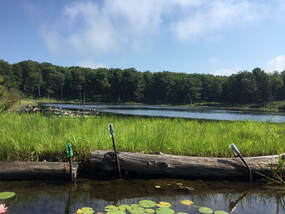CONSERVATION CORNER
A weekly blog for all things conservation
 By: Tess Flynn-Belles, Natural Resource Specialist, Bradford County Conservation District This past year has provided a lot of us with plenty of time to reflect on our properties and home and come up with new ways to freshen the place up. With the amount of calls that the Conservation District received about new pond construction last year, it must have been high on some of your lists! So, with that, we thought we would provide some things to consider before you start. The first thing to consider (let’s get this one out of the way) is whether permits are needed. We won’t go into detail about permitting in this article as it was already covered in a previous article. If you missed that article and would like to read it, you can locate it in our blog on our website under the ‘Ponds’ Category. If you are serious about installing a pond on your property, please call the Conservation District and a staff member will provided technical assistance in determining if there are wetlands present (just because you don’t see cattails, doesn’t mean there aren’t wetlands!) and what other permits may or may not be required.
Second, and most important, is to determine what your primary management objective is. Why are you building this pond? Dreaming about that prime-time fishing spot? Or, maybe, somewhere to cool off during the hot summer months? Maybe a quiet place to sit and observer the natural world surrounding you? Maybe a combination? To achieve and sustain a good fishery it is important to make sure the quality of water will support the species of fish you intend to keep and that there is good habitat. If it’s a good swimming spot you’re after, clean water is a must and you’ll also want to pay attention to plant growth. Too many plants may be an annoyance, but not enough plants may cause an overabundance of nutrients in the water column which will set the stage for potential algae blooms (no fun for anyone!). Ok, what’s next? You’ve determined your primary management objective and the physical and water quality needs to meet your objective. But, are these realistic and achievable goals? To answer this question, you must get to know your watershed! Determine what the primary land use is in the watershed and how it may impact the water quality entering your pond. Are you surrounded by active agriculture land or forests? If your watershed primarily consists of active agricultural land, you’ll want to consider planting a buffer in areas around the pond where nutrient rich stormwater runoff may enter the pond. Planting buffers is a great way to filter out extra nutrients and they also provide great habitat for wildlife. Where will the main water source come from? Will your pond be spring fed or stream fed and will it be a reliable source year-round or only during the wet months? Knowing this will help you get a better idea of the amount of time water stays in a particular pond (or lake) before being replaced with new water, also known as the flushing rate. What type of outlet system will work best, where will it be located, and what will it outlet into? What is the soil type in the area you plan to install your pond, and will it retain water? It is important to remember that every pond is unique and will require specific management techniques to achieve a desired result. Staff at the Conservation District are available to assist you through the process and help you find answers to any of these questions that you may be unsure of. If you are interested in learning more about lake and pond management, become a member of the Bradford County Lake/Pond Management Organization by calling the Conservation District at the number listed below and providing us with your information ($15 annual fee). You will receive access to our newsletters (a fresh one comes out in March!) along with other benefits. Also, check out our website for additional information, resources, and events! The Bradford County Conservation District is committed to helping people manage resources wisely. You can visit the Bradford County Conservation District at 200 Lake Rd in Wysox across from the Wysox Fire Hall. Contact us at (570) 485-3144 or visit our web page at www.bccdpa.com.
0 Comments
Leave a Reply. |
AuthorsVarious staff at the Bradford County Conservation District Archives
July 2024
Categories
All
|
|
Bradford County Conservation District
Stoll Natural Resource Center 200 Lake Road, Suite E | Towanda PA 18848 Phone: (570)-485-3144 |
